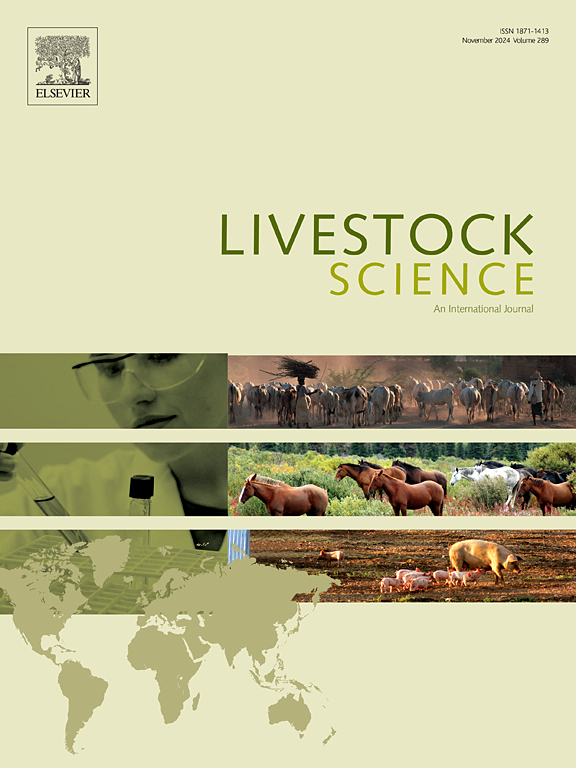Effects of dietary protein digestion kinetics on sow body condition loss and litter performance during lactation: A meta-analysis
IF 1.9
3区 农林科学
Q2 AGRICULTURE, DAIRY & ANIMAL SCIENCE
引用次数: 0
Abstract
Over the last decades, litter size has increased considerably in modern hybrid sows. This raises concerns over body tissue mobilisation during lactation. Recent evidence suggests that protein tissue mobilization is specifically associated with reduced milk production, affecting litter weight gain, and with impaired ovarian function, affecting sow subsequent reproductive performance. Therefore, efficient utilization of dietary protein for milk production is critical during lactation. A meta-analysis was performed to investigate the role of dietary protein digestion kinetics in lactating sow weight loss, litter weight gain and nitrogen loss to the environment. Data were obtained from 17 peer reviewed publications between 1993 and 2019, including 63 different groups of sows fed with 59 different lactation diets. These publications were selected for their research focus on dietary crude protein concentration in relation to sow body weight loss and litter weight gain during lactation. Percentages of slow, fast and resistant protein in the total protein of the diets were estimated based on previously established in vitro protein degradation characteristics of the used ingredients. Results showed that higher total crude protein reduced sow weight losses and estimated body protein losses during lactation (β = -0.07 kg · (g/kg) −1, P = 0.01; β = -0.02 kg · (g/kg) −1, P < 0.01, respectively). An increase in the percentage of slow protein in total protein was associated with decreases of sow total weight loss (β = -1.85 kg/%, P < 0.01), estimated body protein loss (β = -0.33 kg/%, P < 0.01), while the percentage of fast protein in total protein was estimated to increase sow weight loss and estimated body protein loss during lactation (β = 0.46 kg/%, P = 0.03; β = 0.09 kg/%, P = 0.01, respectively). The percentage of resistant protein in total protein did not affect sow body losses but showed a negative relationship with litter weight gain during lactation (β = -0.80 kg/%, P < 0.01). Sow nitrogen loss to the environment during lactation was increased with a higher crude protein in the diet (β = 13.9 g· (g/kg) −1, P < 0.01), but not affected by protein digestion kinetics. This meta-analysis suggests that a high percentage of slow protein reduces sow body protein mobilization during lactation, probably due to a more sustained and prolonged amino acid delivery to the circulation than with fast protein, and therefore improves utilization of dietary amino acids rather than use them as energy source.
饲粮蛋白质消化动力学对泌乳期母猪体况损失和产仔性能影响的meta分析
在过去的几十年里,现代杂交母猪的产仔量大大增加。这引起了对哺乳期间身体组织动员的关注。最近的证据表明,蛋白质组织动员与产奶量减少,影响窝重增加,卵巢功能受损,影响母猪随后的繁殖性能特别相关。因此,在哺乳期间,有效利用饲粮蛋白质来生产乳汁是至关重要的。本试验旨在研究饲粮蛋白质消化动力学对泌乳母猪体重减轻、窝重增加和氮向环境流失的影响。数据来自1993年至2019年期间的17份同行评审出版物,包括63组不同的母猪,分别饲喂59种不同的哺乳日粮。选择这些出版物是因为它们的研究重点是饲粮粗蛋白质浓度与哺乳期母猪体重减轻和窝重增加的关系。根据先前确定的所用原料的体外蛋白质降解特性,估计了饲粮中慢蛋白、快蛋白和耐药蛋白在总蛋白中的百分比。结果表明:较高的总粗蛋白质可显著降低母猪泌乳期体重损失和体蛋白损失(β = -0.07 kg·(g/kg) - 1, P = 0.01;β = -0.02 kg·(g/kg) - 1, P <;分别为0.01)。慢蛋白占总蛋白比例的增加与母猪总重减轻相关(β = -1.85 kg/%, P <;0.01),估计体内蛋白质损失(β = -0.33 kg/%, P <;0.01),而快速蛋白占总蛋白的比例增加了母猪的体重损失和泌乳期体蛋白损失(β = 0.46 kg/%, P = 0.03;β = 0.09 kg/%, P = 0.01)。抗性蛋白占总蛋白的比例不影响母猪体损,但与泌乳期窝重增重呈负相关(β = -0.80 kg/%, P <;0.01)。饲粮中粗蛋白质含量越高,泌乳期母猪对环境氮的损失越高(β = 13.9 g·(g/kg)−1,P <;0.01),但不受蛋白质消化动力学的影响。这项荟萃分析表明,高比例的慢速蛋白质会降低母猪在哺乳期间体内蛋白质的动员,这可能是由于与快速蛋白质相比,氨基酸传递到循环系统的时间更长、更持久,因此可以提高饲料氨基酸的利用率,而不是将其作为能量来源。
本文章由计算机程序翻译,如有差异,请以英文原文为准。
求助全文
约1分钟内获得全文
求助全文
来源期刊

Livestock Science
农林科学-奶制品与动物科学
CiteScore
4.30
自引率
5.60%
发文量
237
审稿时长
3 months
期刊介绍:
Livestock Science promotes the sound development of the livestock sector by publishing original, peer-reviewed research and review articles covering all aspects of this broad field. The journal welcomes submissions on the avant-garde areas of animal genetics, breeding, growth, reproduction, nutrition, physiology, and behaviour in addition to genetic resources, welfare, ethics, health, management and production systems. The high-quality content of this journal reflects the truly international nature of this broad area of research.
 求助内容:
求助内容: 应助结果提醒方式:
应助结果提醒方式:


